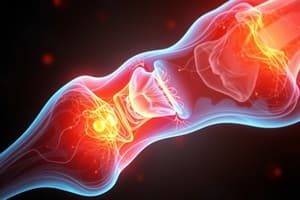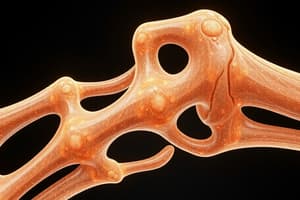Podcast
Questions and Answers
Which type of bone healing requires accurate reduction of the fracture?
Which type of bone healing requires accurate reduction of the fracture?
- Primary bone healing (correct)
- Secondary bone healing
- Neither type of bone healing
- Both types of bone healing
What is the purpose of fracture repair?
What is the purpose of fracture repair?
- To prevent bone collapse and shear
- To facilitate bone healing (correct)
- To manage rotation of the fracture site
- To overcome distraction caused by ligaments or tendons
Which bone aspect is the tension side for the femur?
Which bone aspect is the tension side for the femur?
- Craniomedial aspect
- Lateral aspect (correct)
- Dorsal aspect
- Medial aspect
Which type of bone loading leads to bending of the long bone?
Which type of bone loading leads to bending of the long bone?
Which factor does NOT affect the fracture score?
Which factor does NOT affect the fracture score?
What is the main consideration when choosing the type of fracture repair and implant?
What is the main consideration when choosing the type of fracture repair and implant?
Which force can distract the fracture fragments?
Which force can distract the fracture fragments?
What type of fracture requires increased post-operative care?
What type of fracture requires increased post-operative care?
Which of the following is a reason why fractures may require limited movement during healing?
Which of the following is a reason why fractures may require limited movement during healing?
What is the relationship between strain and the healing of a fracture?
What is the relationship between strain and the healing of a fracture?
In which cases may a fracture in a young animal require limited movement?
In which cases may a fracture in a young animal require limited movement?
What are some problems that can arise from the application of support bandages or casts in young animals with fractures?
What are some problems that can arise from the application of support bandages or casts in young animals with fractures?
Which one of these is an important principle of small animal fracture repair?
Which one of these is an important principle of small animal fracture repair?
Why is it important to take orthogonal radiographs in fracture repair?
Why is it important to take orthogonal radiographs in fracture repair?
What does fracture scoring indicate?
What does fracture scoring indicate?
What is the relationship between fracture scoring and the difficulties in managing a fracture?
What is the relationship between fracture scoring and the difficulties in managing a fracture?
Which tissue forms after granulation tissue during the bone healing process?
Which tissue forms after granulation tissue during the bone healing process?
What is the purpose of widening the gap between bone ends during fracture healing?
What is the purpose of widening the gap between bone ends during fracture healing?
What should be assessed in post-operative radiographs after fracture repair?
What should be assessed in post-operative radiographs after fracture repair?
When should radiographic assessment be made during fracture healing?
When should radiographic assessment be made during fracture healing?
Which factor is NOT considered when scoring fractures?
Which factor is NOT considered when scoring fractures?
Which type of fracture requires increased post-operative care?
Which type of fracture requires increased post-operative care?
Which physiological force can distract fracture fragments?
Which physiological force can distract fracture fragments?
Which is the first step in small animal fracture repair?
Which is the first step in small animal fracture repair?
Which bone aspect is the tension side for the femur?
Which bone aspect is the tension side for the femur?
Why is it important to take orthogonal radiographs in fracture repair?
Why is it important to take orthogonal radiographs in fracture repair?
What does fracture scoring indicate?
What does fracture scoring indicate?
What is the relationship between fracture scoring and the difficulties in managing a fracture?
What is the relationship between fracture scoring and the difficulties in managing a fracture?
Which tissue forms after fibrocartilage during the bone healing process?
Which tissue forms after fibrocartilage during the bone healing process?
What is the purpose of widening the gap between bone ends during fracture healing?
What is the purpose of widening the gap between bone ends during fracture healing?
When should radiographic assessment be made during fracture healing?
When should radiographic assessment be made during fracture healing?
What is the main consideration when choosing the type of fracture repair and implant?
What is the main consideration when choosing the type of fracture repair and implant?
Which of the following is NOT a tension aspect of a long bone?
Which of the following is NOT a tension aspect of a long bone?
Which type of bone healing requires accurate reduction of the fracture?
Which type of bone healing requires accurate reduction of the fracture?
What type of force can cause bending of the long bone?
What type of force can cause bending of the long bone?
Which of the following is NOT a method for achieving secondary bone healing?
Which of the following is NOT a method for achieving secondary bone healing?
Which type of fractures may naturally have little movement during healing?
Which type of fractures may naturally have little movement during healing?
What can happen if there is a small gap and excessive movement in a fracture?
What can happen if there is a small gap and excessive movement in a fracture?
What are some problems that can arise from the application of support bandages or casts in young animals with fractures?
What are some problems that can arise from the application of support bandages or casts in young animals with fractures?
What is the main reason for cage resting a young animal with a fracture?
What is the main reason for cage resting a young animal with a fracture?
Which tissue forms after fibrocartilage during the bone healing process?
Which tissue forms after fibrocartilage during the bone healing process?
What is the purpose of widening the gap between bone ends during fracture healing?
What is the purpose of widening the gap between bone ends during fracture healing?
What is the main consideration when choosing the type of fracture repair and implant?
What is the main consideration when choosing the type of fracture repair and implant?
What type of fractures may naturally have little movement during healing?
What type of fractures may naturally have little movement during healing?
What does fracture scoring indicate?
What does fracture scoring indicate?
What should be assessed in post-operative radiographs after fracture repair?
What should be assessed in post-operative radiographs after fracture repair?
What is the relationship between fracture scoring and the difficulties in managing a fracture?
What is the relationship between fracture scoring and the difficulties in managing a fracture?
What are some problems that can arise from the application of support bandages or casts in young animals with fractures?
What are some problems that can arise from the application of support bandages or casts in young animals with fractures?
Which type of bone healing requires accurate reduction of the fracture?
Which type of bone healing requires accurate reduction of the fracture?
Which type of fracture requires increased post-operative care?
Which type of fracture requires increased post-operative care?
Granulation tissue will withstand 100% strain whereas bone will only withstand 2% strain. Granulation tissue forms then your fibrous tissue than fibrocartilage and you then get cars forming and then you get the bone and that process slowly reduces the strain as you get less movement as all the tissues become a little bit more rigid which allows the formation of the next layer of tissue. To reduce the strain the gap can be widened - bone ends reabsorb all the fracture becomes progressively stiffer by the formation granulation tissue callous and finally bone. Formation of the callus creates greater stability and reduced movement at the fracture site and the strain decreases. Management of Strain: • Strain is equal to the change in length divided by the original length • The body will initially resorb the end of the bone to the fracture and now increases the fracture gap and therefore reduce the strain which aids the initial healing process. Post Operative Assessment: • Once we've done the fracture repair we have to take post-operative radiographs to make sure that • the fracture is completely aligned • The positioning of the implants • The encroachment of implanted joint a soft tissues of the bridging of growth plate in young animals § If this is not addressed it can lead to angular limb deformity. Monitoring: • This interval may be great if the animal is doing well and varies with the implants employed for example a external ______ may require a weekly examination is the complication rate is higher whereas a plate repair may only require an examination at monthly intervals if it is progressing well • Radiographic assessment should be made: • Prior to the removal of implants • If progression is not as anticipated • Or if there is evidence of sepsis Summary: • You want to assess the animal • You want to then take radiographs • You don't want to score the fracture • Then you want to consider what forces need be counteracted • Fix the fracture and then take post-operative radiographs so as to be confident that the fracture suitably repaired • Monitor the progress of the fracture clinically and radiographically particularly if the fracture healing appears prolonged an animal is not progressing as anticipated
Granulation tissue will withstand 100% strain whereas bone will only withstand 2% strain. Granulation tissue forms then your fibrous tissue than fibrocartilage and you then get cars forming and then you get the bone and that process slowly reduces the strain as you get less movement as all the tissues become a little bit more rigid which allows the formation of the next layer of tissue. To reduce the strain the gap can be widened - bone ends reabsorb all the fracture becomes progressively stiffer by the formation granulation tissue callous and finally bone. Formation of the callus creates greater stability and reduced movement at the fracture site and the strain decreases. Management of Strain: • Strain is equal to the change in length divided by the original length • The body will initially resorb the end of the bone to the fracture and now increases the fracture gap and therefore reduce the strain which aids the initial healing process. Post Operative Assessment: • Once we've done the fracture repair we have to take post-operative radiographs to make sure that • the fracture is completely aligned • The positioning of the implants • The encroachment of implanted joint a soft tissues of the bridging of growth plate in young animals § If this is not addressed it can lead to angular limb deformity. Monitoring: • This interval may be great if the animal is doing well and varies with the implants employed for example a external ______ may require a weekly examination is the complication rate is higher whereas a plate repair may only require an examination at monthly intervals if it is progressing well • Radiographic assessment should be made: • Prior to the removal of implants • If progression is not as anticipated • Or if there is evidence of sepsis Summary: • You want to assess the animal • You want to then take radiographs • You don't want to score the fracture • Then you want to consider what forces need be counteracted • Fix the fracture and then take post-operative radiographs so as to be confident that the fracture suitably repaired • Monitor the progress of the fracture clinically and radiographically particularly if the fracture healing appears prolonged an animal is not progressing as anticipated
Flashcards are hidden until you start studying




